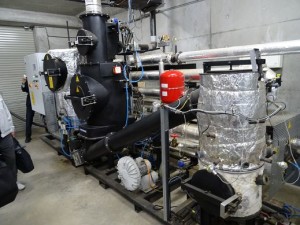“Prospects of Modern Wood Gas Cogeneration Renewable Energy Supply in Japan – Case Study of ICU” is an essay addressing the introduction of a scalable modern commercial wood gas cogeneration technology of micro scale in nowadays Japan.

unit (wood to gas) of Spanner K.K. installed 2014 in Ecomura near Koriyama,
Fukushima Prefecture, Japan.
The first Japanese wood gas cogeneration plant was built in Koriyama, Fukushima Prefecture, in 2014, and it has been running since then. It showed how important is to provide energy with dry wood chip for ensuring a high-quality fuel, but the real unsolved question is related to which may be the contribution of such technology to the entire Japanese renewable energy supply.
A close debate with experts from different society sectors and a technical tour to visit running projects’ plans in several countries, where this technology is commonly used, helped in focusing some important aspects being related to the above-mentioned issue.
Training and knowledge transfer from long-experienced scientific communities and a certification system in agreement with ISO norms guidelines would be essential to ensure needed quality standards and to cut potential risks off (that are, by the way, rather low). A local woodchip supply chain is a key feature in terms of long-term cost efficiency as well as for forest ecology matter. Although there are variations according to local conditions in Japan, general unharvested annual increase in wood biomass secures a certain stability in the supply, while the same cannot be said regarding fossil and nuclear fuels.
The wood gas cogeneration technology is extremely attractive for investment in Japan since there are several subsidies to apply for. On the 1st of April 2015, the Japanese government has raised the existing feed-in-tariff for electricity produced from wood biomass by forest maintenance from the previous 32 JPY/kWh to the current 40 JPY/kWh. In addition to that, the New Energy Promotion Council of Japan subsidizes heat energy being produced from wood gas cogeneration plants and from biomass conversion in general. “We therefore summarize from this section that economically wood gas cogeneration is currently in Japan a very attractive option, with payback times of less than seven years and potentially much less than that, if feed-in-tariffs, actual consumer side energy costs, available subsidies and further likely cost savings are properly taken into account.”
As a case study, this research considered the energy supply for the International Christian University (ICU) campus in Mitaka (Tokyo). ICU campus forest is intensively maintained: by this way ICU forest management provides for at least 50 tons of wood chips per year or more, since it may further increase this number. Public gardens and parks surrounding the university campus may furnish additional feedstock to guarantee the continuous operativity of the wood gas generator, with due regard for nearby natural protected area.
This kind of solution is highly adaptable and therefore transferable to other private and public institutions and to many types of building being located next to major public parks or forests (especially in western Japan).
Universities, as pioneers of this technology, with students and academic experts being involved, may generate the so-called phenomenon of “decoupling of profit and fossil and nuclear energy consumption, accompanied by decoupling of energy consumption and quality of living”. According to recent statistics, the potential sustainable production of wood biomass electricity through wood gas cogeneration can cover more than 1% of the national electricity demand (about 26.7 TWh). This would stimulate a considerable improvement in the living conditions of the Japanese and a general remarkable consumption reduction, especially concerning warm water production and heating in winter and air conditioning in summer.
This post by Chiara Pappalardo is based on the article “Prospects of Modern Wood Gas Cogeneration Renewable Energy Supply in Japan − Case Study of ICU” by Eckhard Hitzer, Mark Langager, Nobyuki Miyazaki, Takashi Kibe.
To read the whole article, please click here.


